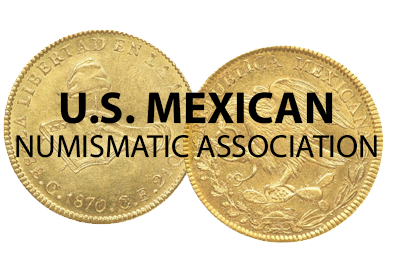Las Tesorerías de la Nación
After Iturbide was exiled, the newly formed Republic decreed the withdrawal of Iturbide's notes and the creation of a new issue of paper money in the same denominations ($1, $2 and $10) drawn on the National Treasury to replace themGazeta del Gobierno Supremo de México, Tomo I, Núm. 51, 17 April 1823.
These notes were printed on the back of Papal Bulls (Lent authorizations) dated 1816, 1817, 1818 and 1819. The notes bear the date of decree, 11 April 1823, and date of issue, 5 May 1823.
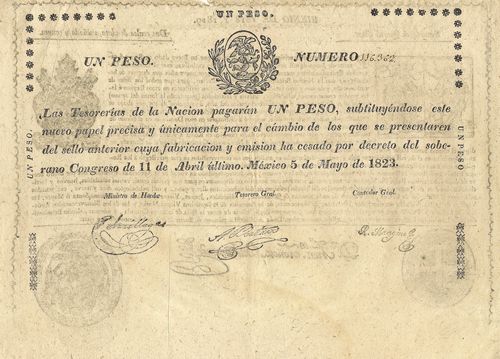
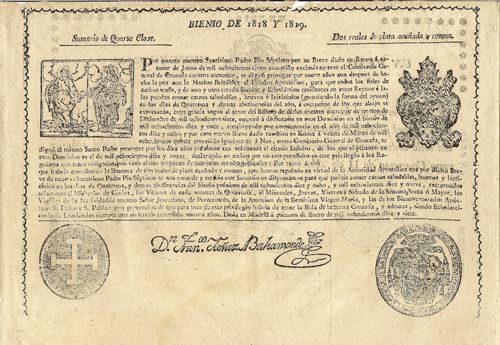 M15a $1 Las Tesorerías de la Nación
M15a $1 Las Tesorerías de la Nación
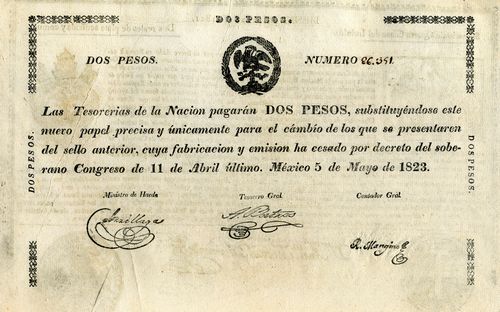 M16a $2 Las Tesorerías de la Nación
M16a $2 Las Tesorerías de la Nación
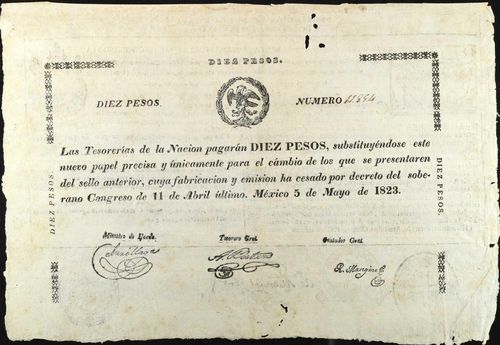
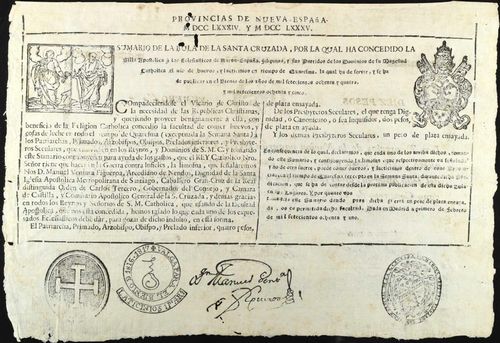 M17a $10 Las Tesorerías de la Nación
M17a $10 Las Tesorerías de la Nación
| from | to | total number |
total value |
||
| $1 | includes numbers 116133 to 126223 | ||||
| $2 | includes number 82181CNBanico #1954 to 86391CNBanico #10702 | ||||
| $10 | includes numbers 8109CNBanico #1958 to 16744 | ||||
| $860,000 |
These have the stamped signatures of Francisco de Arrillaga as Ministro de Hacienda, Antonio Batres as Tesorero General and Rafael Mangino as Contador General.
|
Francisco de Arrillaga was born in Vizcaya, Spain and set up a casa commercial in Veracruz at the beginning of the 19th century. He was one of the leading liberals in the city and supported the insurgents during the War of Independence. He was Ministro de Hacienda from 2 May 1823 until 8 August 1824 in the first federal government. In 1837, under the administration of Anastasio Bustamante, his casa comercial obtained the first concession to build a railway from Veracruz to Mexico City; however, opposition from his business rivals led the project to fail. |
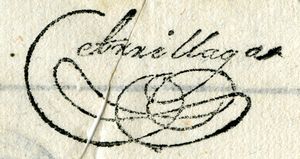 |
| Antonio Batres | 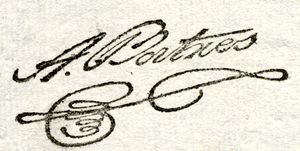 |
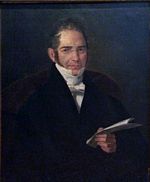 Rafael Mangino y Mendívil was born in Puebla in 1788. After service in the army and travelling through Europe he was employed in the Administración de Tabacos in San Luis Potosí and, in 1819, as secretary of finance in Valladolid (today Morelia). When Iturbide occupied Puebla in August 1821 Mangino offered his services and was named Tesorero General of the Army of the Three Guarantees (Ejército Trigarante). As Presidente of the first Congress he was the person who actually crowned Iturbide as Emperor. This first Congress appointed him as Contador Mayor de Hacienda. He was minister of Hacienda on two occasions, in 1830 to 1832 and again in 1836, where he increased revenues, organised the oficinas recaudadoras and established the Dirección General de Rentas. He died in Mexico City on 14 June 1837. Rafael Mangino y Mendívil was born in Puebla in 1788. After service in the army and travelling through Europe he was employed in the Administración de Tabacos in San Luis Potosí and, in 1819, as secretary of finance in Valladolid (today Morelia). When Iturbide occupied Puebla in August 1821 Mangino offered his services and was named Tesorero General of the Army of the Three Guarantees (Ejército Trigarante). As Presidente of the first Congress he was the person who actually crowned Iturbide as Emperor. This first Congress appointed him as Contador Mayor de Hacienda. He was minister of Hacienda on two occasions, in 1830 to 1832 and again in 1836, where he increased revenues, organised the oficinas recaudadoras and established the Dirección General de Rentas. He died in Mexico City on 14 June 1837. |
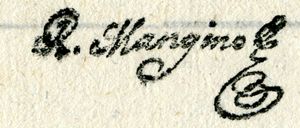 |
According to a report of Antonio Batres on 21 March 1823CEHM, Fondo VIII-4 Manuscritas de Román Beltrán, carpeta 11, legajo 506 $860,000 was printed. However, according to a report of the Secretaría de Hacienda on 3 November 1823 $475,000 were printed of which $359,675 was put into circulation, in exchange for Iturbide notes, whilst $115,325 still remained with the Treasury. By the end of October $176,919 had been amortised and $182,756 was still in circulation.
